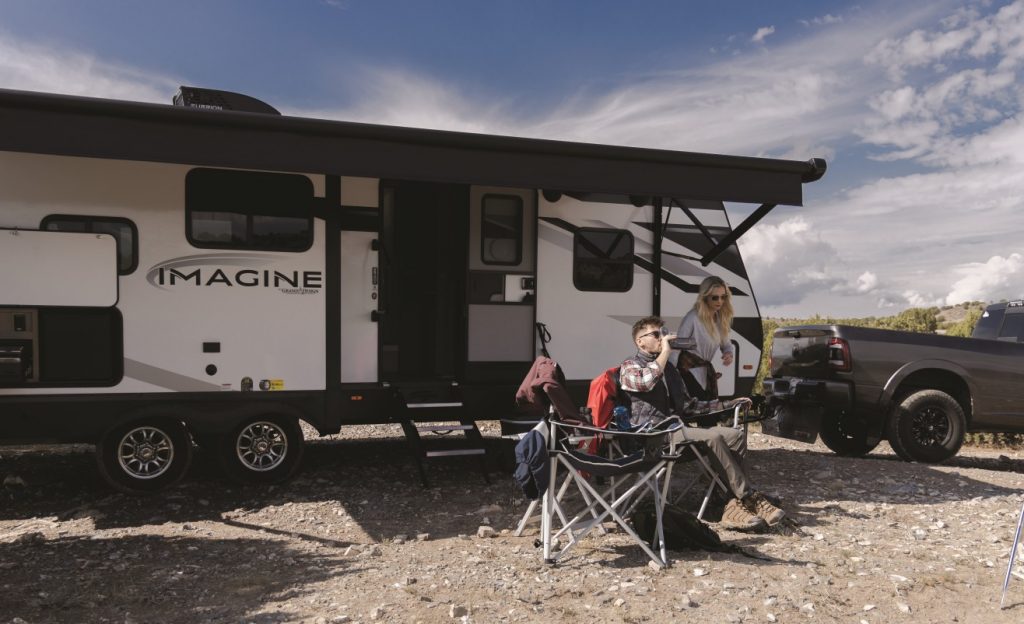
Have you wondered why RVs, even those in the same class, like travel trailers, can have drastically different prices? Navigating differences in travel trailers can feel like a lot of information, so we want to use our years of experience with RVs to break down why one travel trailer is priced so different from another and what kind of options different levels of RVS offer, so you can have all the information you need to know what tier of travel trailer is best for you.
The different travel trailer tiers are similar to what you’d find in a regular vehicle. If you are shopping for a Ford F-150, you’ll find a luxury model that has special options like power seats, tinted windows, four-wheel drive, and a backup camera, a mid-level model with a sprinkling of those options and an entry-level model has none of them (while still being a fully functional truck). When you look at different travel trailers, you’ll find similarly different options.
Unlike trucks, there is no single, cut and dry, standard set of options between levels of campers and RVs. However, some features that may set one tier apart from another are options like manual leveling packages vs electric or automatic, aluminum vs fiberglass siding, and interior features like different cabinet construction, A/C capability, and control board systems.
Here we’ll break down what types of features you can expect in an entry-level, mid-level, and luxury travel trailer, and the range you can expect to pay for each tier.
What to Expect in an Entry-Level Travel Trailer
Priced between $12k and $40k, a new entry-level travel trailer will typically be built using stick and tin construction and include the basic features needed for RV camping. Like the entry level truck, it will do the job, but without a lot of frills.
You can generally expect these features in an entry-level travel trailer:
- Stick and tin construction with batten insulation
- Manual stabilizers and tongue jacks
- Base-level interior finishes and cabinetry
- Limited technology in the TVs, radio, speakers, and lighting (inside and out).
- Solar prepped, but not installed
- Steel wheels and generic tires
What is Stick and Tin?
Stick and tin refers to the construction of the exterior walls on the trailer. The walls are framed with wood (stick) and the exterior siding material is aluminum (tin). The camper walls are insulated with batten insulation, the same product (rolled foam insulation) you see in home construction. This is a lower-cost building process that allows the RV to stay within the lower price range. There are a few manufacturers that will offer an entry-level, fiberglass-sided trailer as well. (See above video for explanation)
Manual Stabilizer Jacks
Stabilizer jacks are what stabilize the camper when you are at the campsite (check out the video below for more info). In the lower-entry campers, most manufacturers will have manual stabilizer jacks and tongue jacks installed. Manual jacks are much less expensive than the all-electric alternative.
Base-Level Finishes
On the interior of an entry-level camper you can expect to see veneer-wrapped particle board cabinets, rather than the solid wood construction you will see in more luxurious campers. Other finishes, like composite countertops, basic hardware, and linoleum flooring are pretty standard across all price levels.
Limited Technology
Technology within an entry-level unit is quite basic. You’ll find interior lights that are typically small LEDs with translucent covers (without the option of dimming), control boards with analog switches vs a tablet screen or updated command center. If the trailer has a slide out, it will probably have either a rack-and-pinion drive or a cable drive electric system, both of which typically have a manual backup in case problems occur.
Solar Prepped vs Solar Installed
While solar is very popular within the RV industry right now, most entry-level units will only be prepped for solar. This means that the trailer will have connections to add solar on the side or the roof, but will not come with a solar controller.
Wheels and Tires
You can expect to see steel wheels with off brand tires.
I’ve only scratched the surface of all the entry-level trailers out there. Entry-level is definitely a subjective measure on a customer-to-customer basis based on their wants and needs.
What to Expect in a Mid-Level Travel Trailer
Priced between $25k and $60k, new mid-level travel trailers are mostly steel frame and fiberglass side construction with more electric features and overall nicer interior features.
In a mid-level travel trailer you can expect:
- Steel frame and fiberglass exterior
- Electric Jacks
- Higher quality interior finishes and cabinetry
- Upgraded technology in the TVs, radio, speakers, and lighting
- Solar installed
- Exterior design and custom wheels
- Extended season packages
Alumnim Frame and Fiberglass Exteriors
Construction materials create the main difference between entry and mid-level travel trailers. Aluminum framing and fiberglass construction creates a more streamlined appearance and generally makes the trailer both lighter and more durable.
Electric Jacks
In the mid-level range, you’ll start seeing more electric (not to be confused with automatic) stabilizer and tongue jacks. Some travel trailers in this range will even have electric jacks with a manual backup option. Since electrical components can be temperamental, this manual option can come in handy.
Higher Quality Finishes
In the mid-range, you’ll see nicer light fixtures, soft-close rolling shades, hard surface countertops, and solid wood cabinetry with upgraded hardware. Some units may also have upgraded mattresses and storage space.
Upgraded Technology
Technology really separates the mid-level from the entry-level units. You will find better TVs, interior and exterior sound systems, digital control boards (some with Bluetooth capabilities), and some units include LED backlighting to add a fun ambiance to the RV.
Solar Installed
This is not a guarantee, since every dealer can order their inventory differently, but for the most part you will see solar panel(s) already installed across most lines of mid-level travel trailers. Solar panel sizes will typically be around 50 to 200 watts with 30amp controllers. Some owners add more panels after the sale and most dealers have the capability to do so as well. Most manufacturers also use thick enough gauged wire for the RV owner to add up to 500 watts of solar panels to the roof without having to upgrade the whole wiring system, however, if this is important to you, make sure you check before you buy.
Exterior Design / Wheels and Tires
Exterior design in the mid-level segment becomes much flashier than entry-level, with more custom design and a better overall look to the trailers. Custom and/or upgraded wheels are another touch the mid-level trailer will have over entry-level. You will also start to see more name-brand tires such as Goodyear.
Extended Season Packages
Extended season packages are a huge bonus to mid-level travel trailers. Basically, this means the underbelly of the trailer is enclosed and also, to some degree, heated, allowing you the ability to more comfortably camp earlier in the spring and later into the fall. This is not to be construed with Four Season packages. Video explanation
What to Expect in a Luxury Travel Trailer
With aluminum framing, fiberglass exterior construction, high-end interior design, upscale finishes, and automated features, you can expect to pay between $50k and $80k for a new luxury travel trailer.
Luxury travel trailer features may include:
- Aluminum frame and fiberglass exteriors.
- Electric stabilizer jacks and/or automatic leveling jacks.
- Luxury interior finishes and cabinetry.
- Top of the line technology in TVs, stereo, sound system, lighting, Bluetooth, smartphone capabilities.
- Solar installed and possible generator or generator prepped.
- Exterior design with custom wheels.
- Extended or four-season packages.
Aluminum Frame and Fiberglass Exteriors
Luxury campers have lightweight steel construction with fiberglass exteriors, quite similar to what you’ll find on the middle-tier trailers. At this level your front caps may likely be made completely from fiberglass, making for a simpler repair process should the front caps ever sustain road or storm damage.
Electric Jacks and/or Automatic Leveling
The luxury segment is where automatic leveling jacks appear on travel trailers. This is a one button automatic system that, using either electric or hydraulic systems, levels your trailer when you are parked at a campsite. Most of these trailers will have electric stabilizer jacks, but not all. For example, the Northwoods Nash and Arctic Fox travel trailers only come with manual stabilizer jacks yet are seen as some of the higher-end travel trailers.
Luxury Finishes
At this tier, you’ll find finishes that make the RV feel a little more like home. You may find granite countertops, higher-quality cabinet finishes, upscale trim work, and light fixtures. Some luxury travel trailers also have a higher ceiling height, making the trailer feel more spacious.
Top of the Line Technology
These trailers get technical! You’ll find tablet control boards and smartphone capabilities allowing you to change temperatures in your camper even when you are miles from your trailer. It can also include the ability to dim your inside and outside trailer lights, all from your phone. The tablets include every control needed for your whole RV, and some even have backup analog switches. You may also see sound systems like Sony and Bose.
Solar Installed/Possible Generator or Generator Prepped
It’s becoming more and more common for new luxury trailers on the market today to have solar panels mounted on their roofs. Some of the luxury trailers, in addition to having solar panels, will also have a generator installed or, at the very least, be prepared to have a generator fitted. In the event that a generator is included, it will likely be an Onan brand generator.
Exterior Design/Wheels
Luxury campers will definitely be eye-catching. Along with full-fiberglass front caps the trailer will possibly also use automobile paint and have custom wheels. Typically, you can expect a larger interior space, which makes for a higher stance trailer.
Extended Season/Four-Season Packages
A luxury travel trailer will almost always have an extended season or four season package. Extended-season campers typically include heated and enclosed underbellies, as explained earlier in the mid-tier section. A camper really becomes capable of four-season camping when tank pads are added to the holding tanks. Tank pads cover the storage tanks with heating elements which provide additional insulation for your storage tanks, decreasing the likelihood that the tanks will freeze over. Some manufacturers claim to beef up the insulation in the trailer walls as well, to further insulate the RV for colder temperatures.
There is some controversy on the meaning of a “Four Season Camper,” and it really comes down to temperature. Without even more added protection, a four-season RV will freeze up if you’re camping during the winter in Nebraska. If you’re camping during all four seasons in Texas, on the other hand, you’d be just fine!
In Conclusion
So, you see, while prices for travel trailers vary widely, there are also many different options and features available. Now you have a basic guide to understand the differences between entry, mid and luxury travel trailers.
At Bish’s RV, we have over 20 years of experience helping RVers find the right unit for their budget. We’d love to help you find the perfect travel trailer for you. Give us a call or click here to make an appointment to see RVs in person at your closest Bish’s dealer.
